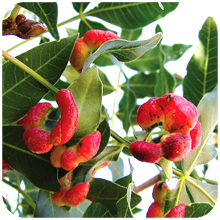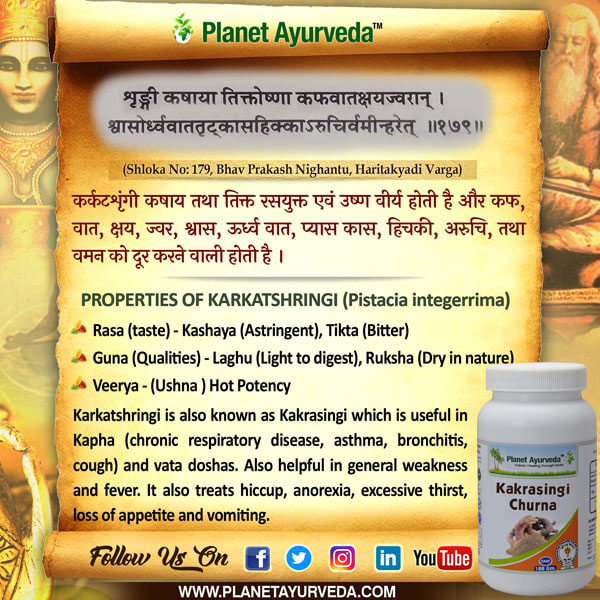Karkatshringi (Pistacia integerrima) – Uses, Benefits, Dosage, Properties

Description of Plant
It is a glabrous shrub, dark grey or blackish bark and grown unto 16m. Leaves are 20-25 cm in length, with or without terminal leaflet; leaflets 4-5 pairs, lanceolata, coriaceous and base oblique. The odor of this shrub is Peculiar. Leaves are dark green in color which turn bright red in autumn. This is the time when they are more easily recognized. Flowers are in lateral panicles, male compact, pubescent, female lax and elongate. Plant wear the flowers and fruits in spring, which have large clusters of tawny colored fruit in winter. These fruits are eaten and spread by many species of birds. Seeds of plant are with a membranous testa.
General Information
In Sushurta samhita, Karkatshringi is classified as poisonous tuber. It is herb which produces srngi (gall) which are produced by an insect – Dasia asdifactor. This insect produces the horn like outgrowths on the branches of this herb which are called as Karkatshringi. These are large, hollow, thin-walled, generally cylindrical and tapering to either extremity. These galls (srngi) are packed with therapeutic properties and considered as tonic. Expectorant properties of this herb are quite effective to resolve the complications like cough, asthma, phthisis, fever, tuberculosis and irritability of stomach. This herb helps in clearance of mucus from airways, bronchi, lungs and trachea. Antimicrobial activities of this herb are quite good to fight against viral, bacterial and fungal infections. Use of this herb is quite effective in the treatment of children’s diseases. Use of this herb is good to treat the gum diseases also. Besides galls, all the other plant parts like leaves, bark and seeds have therapeutic properties.
Phytochemical constituents – Essential oils, resin, pistacienoic acids A & B, 3- sitosterol, aromadendrene, camphene, caprylic acid, cineol, a— pinene, amino acids, dihydromalvic acid, pistacin, pistacinin, sterals, triterpenoids and dihydroquercetin. These phytochemical compounds also offers the various health benefits and help in treatment of diseases.
Habitat
It is native of China and Japan. But also found in England. In India it is grown in the temperate Himalayas, from Kashmir, Sikkim to Bhutan at altitudes of 600–2,500 m.
Classification
- Kingdom – Plantae
- Family – Pistaciaceae
Names
- Latin Name: Pistacia integerrima
- English name: Crabs claw
- Hindi name: Kakadasrngi, Kakarasingi
- Kannada name: Kaakada shringi, Karkatakasrngi
- Tamil name: Kakkata shrinigi
- Telugu name: Kakarsingi, Karkatakashrungi
- Malayalam name: Karkkatasrmgi
- Bengali name: Kankda Shringi
- Assamese name: Kakiasingi
- Gujarati name: Kakadashing
- Kashmiri name: Kakkar, Kamaladina
- Marathi name: Kakadshingi
- Oriya name: Kakadashringi
- Punjabi name: Kakar, Kakarsingi
- Urdu name: Kakra, mastagi desi
Ayurvedic Properties
| Hindi / Sanskrit | English | ||
| Rasa | Tikta, Kasaya | Taste | Bitter, Astringent |
| Guna | Laghu, Ruksa | Physical Property | Dry |
| Virya | Ushna | Potency | Hot |
| Vipaka | Katu | Metabolic Property (After Digestion) | Pungent |
Effects on Doshas
It balances vata and kapha doshas.
Classical categorization
| Charak Samhita | Sushrut Samhita | Vagbhata |
|
|
|
Ancient Verse about Karkatshringi

The Bhavprakash nighantu edition of 1998: verse 178-179, page no- 98-99.
Its names are Srngi, Karkat Srngi, Kulir, Vishanika, Ajsringi, Chakra and Karkatakhya. This is astringent and bitter in taste with hot potency. It manages the Kaphaj and vataj fever, tuberculosis, respiratory problems, cough, thirst, hiccups, anorexia and vomiting.
References
The Bhavprakash nighantu with elaborated Hindi commentary by Padmashri prof. K.C. Chunekar, edited by Dr. G.S. Pandey: edition of 1998: verse 178-179, page no- 98-99.
Practical Uses of Karkatshringi
This herb is quite good in the problem of edema (swelling). It helps to reduce the fluid accumulation in the tissues. Furthermore this herb also helps to provide the relief in the problem like swelling in legs, hands, arms, ankle and feet which are associated with edema.
- Use of this herb is quite good in the gum diseases like pyorrhea, gingivitis etc. Decoction of this herb help to remove the pus from gum. Furthermore its anti-inflammatory properties help to reduce the pain.
- This herbs is packed with wound healing properties and thus help in healing of wounds and cuts.
- Being carminative and astringent in n properties. It helps to reduce the flatulence in gastrointestinal tract. Thus this herb is quite effective in the treatment of diarrhea, anorexia and dysentery.
- This herb is also good to resolve the respiratory complications. It is good to treat the cough and dyspnea. Being bitter and pungent in taste it acts as expectorant and helps in clearance of mucus from airways, bronchi, lungs and trachea. Moreover it helps to manage the hiccoughs. Hence this herb strengthens the respiratory membrane inner lining of the surface Karkatshringi is known to be an effective herb in the treatment of tuberculosis.
- This herb supports the good health of female reproductive system. Helps in the removal of debris and impurities after menstruation. It help in the healing of uterine lining too.
- This herb has the antipyretic properties hence it is good in the treatment of fever.
- Antimicrobial activities of herb are quite effective to resolve the various bacterial, viral and fungal infections.
- It has been found that Karkatshringi is herb which has the anti-cancerous properties. It helps to reduce the growth of cancer cells in a natural way.
- Use of this herb is quite good to treat the whooping cough and asthma in children.
- It acts as spermato genetic and spermatopoietic agent. Use of this is very effective to increase the sperm count and also helps to improve the quality of sperm. This herb is known to be quite good to resolve the male sexual health issues. It helps to increase strength, vigor and libido in men.
Classical Reference
Parts Used
Galls
Dosage
2-4 grams.




